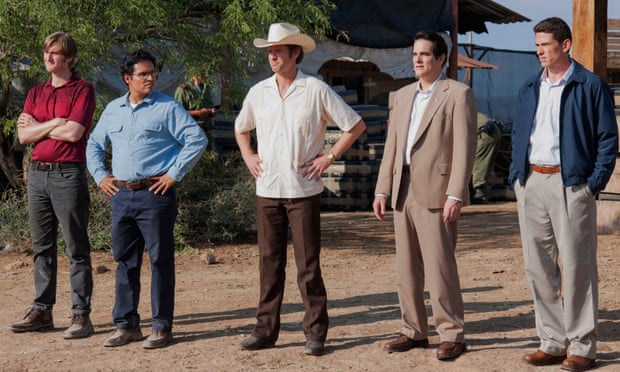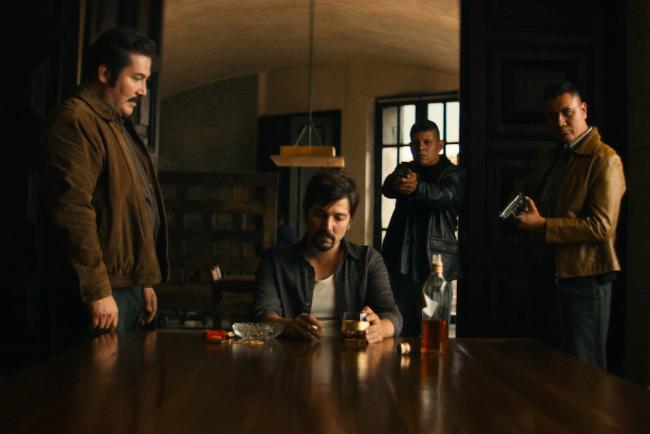Narcos: Mexico
"A show for people who want the drug war to last forever"
Narcos: Mexico is the story of Mexico’s first drug kingpin,
Miguel Ángel Félix Gallardo (Diego Luna). The 10 episodes that premiere
this week detail the dramatic implosion of Gallardo’s empire, a collapse
that makes for extremely bingeable television. Yet, despite the
thrilling spectacle, exhaustion seeps in. Even though it aims at being
something more, Narcos: Mexico doesn’t seem to have ambitions far beyond those of the criminals it follows, pushing more product.
All
druglord sagas are alike. A driven young man with a flash of insane
ambition in his eyes, who’s smarter, more brutal or luckier than his
rivals, rapidly ascends a teetering mountain of cash, corpses and
addictive substances. Then his appetite for success overtakes him and
there’s a reckoning.
For the ordinary U.S. viewer, Narcos Mexico is likely the only representation of Mexico they will consume all year. Even in this saturated “peak TV” market, Narcos Mexico catapulted to the top five streaming shows on Netflix in the United States. One week after its February 13, 2020 release, the show boasted nearly 50 million average demand expressions. The popularity of Narcos Mexico is
easily explained: It is a well-crafted show with a big production
budget, stellar acting, and a strong aesthetic sensibility. It also
doesn’t hurt that it delivers a pre-history of the inter-cartel violence
that fascinates U.S. audiences. Despite its claims to accuracy,
however, this season of Narcos Mexico delivers a DEA version of
events, silencing the anti-left politics that undergirded the expansion
of the drug trade in the 1970s and 1980s.

While it was created by three U.S. men, Narcos Mexico provides
a strong sense of place thanks to the Mexican directors, writers, and
actors who helped make the show, which was filmed on location. U.S.
viewers, who may have little knowledge of Mexico beyond sensationalist
headlines and trips to Cancún, can thus witness the distinct regional
geographies of the country, from the vast Chihuahuan desert to the dense
cityscapes of the Federal District and Guadalajara. If they are
attentive, they may even notice the characters’ distinct regional
Mexican accents. Perhaps for this reason, the show has also found an
audience in Mexico, where on February 26 it was ranked the number two
show on the platform.
Throughout, Narcos occasionally makes overtures at the grander
significance of the story it’s telling. Across 10 episodes, Gallardo’s
desperate maneuvers to retain control of his business and stick it to
those who have slighted him have consequences that reverberate beyond
the criminal underworld, ultimately resulting in a rigged presidential
election. “Sound familiar?” the show’s narrator winks.

The show’s conscience is
Michael Peña
as DEA agent Kiki Camarena, who arrives in Guadalajara as Gallardo’s
operation is gaining momentum, and is aghast at his new colleagues’
inadequacy. The institutional corruption that was the backdrop to the
original Narcos is even more explicit here, as Camarena’s
resourcefulness and obsessive desire for justice runs repeatedly into
interference from above, most infuriatingly from a US embassy that’s
following a vague but malign agenda of its own. This is the beginning of
the modern war on drugs, where law enforcement officers who actually
want to enforce the law will find that someone somewhere has their thumb
on the scales. Peña initially plays Camarena’s irate fussiness for
laughs, before bringing dignity and tragedy to a hopeless quest that
ensures Narcos: Mexico is a layered drama with political nous, and not
just a snorting frenzy of cheap glamour and throwaway murder.

The second season of Narcos: Mexico wants to make a point about
consequences, at least on a surface level. The collapse of Gallardo’s
empire stems directly from brash actions taken during his ascent — most
directly, the murder of DEA agent Kiki Camarena (Michael Peña), which
sends agent Walt Breslin on a reckless mission of retribution. There are
also bridges burned along the way, friendships set ablaze to use as
fuel for ambition that leave many eager to see Gallardo out of power.

By the season two finale, the federation has dissolved, and Mexico’s
trafficking routes have been divided geographically among the different
organizations. In one of the show’s final scenes, when Félix Gallardo
and Breslin finally meet, the former predicts that, absent his
leadership, Mexico will soon descend into violence. However, such claims
wrongly suggest that the spectacular violence witnessed today was the
result of organizational disunity rather than the government’s
militarized war on drug trafficking organizations. Such representations
are not without political consequences.

“I’ve always sort of seen this as of the Marvel superhero universe of
connecting narcotraffickers, and that they all coexist,” showrunner Eric
Newman
told The Hollywood Reporter
not long after the season premiered in 2018. It’s a crass way of
describing the dynamics at play in these stories of cartels and
corruption, but also a very American one. The gringos, as the Mexicans
doing the dirty work for the cartel bosses say, always want more. And
what better expression of “more” is there than the excesses of the
modern cinematic universe?
You could tell this story indefinitely, because it is still being told
today, with every story of a white person enraged at the sound of
Spanish being spoken, with every ICE raid, with every chant for the
wall. Cartel dramas like Narcos are fairy tales for a nation in
decline, flattening diverse and complicated countries for the benefit
of a nation that refuses to acknowledge the havoc it has wreaked on the
world.
-------Dwaipayan Mondal------
:format(webp)/cdn.vox-cdn.com/uploads/chorus_image/image/66315856/Screen_Shot_2020_02_14_at_2.44.35_PM.0.png)




:format(webp):no_upscale()/cdn.vox-cdn.com/uploads/chorus_asset/file/19720979/Screen_Shot_2020_02_14_at_2.43.45_PM.png)

Comments
Post a Comment